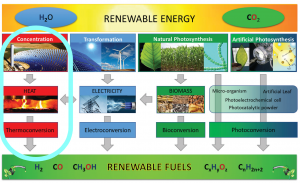Nils Ulrich
Today’s world runs on fossil fuels. They are not only used to transport humans or goods, but also to produce energy, to heat buildings and count as important compounds in the industry. The only problem is that they are the main source of the human made climate change, due to the fact, that they release CO2 when burnt. Therefore, it is of high importance to find a sustainable replacement for fossil fuels. Solar fuels could exactly be such a replacement because of their CO2 neutrality and specific characteristics. But for now there is still uncertainty, as it will take years to come until they are ready for mass usage.
How are solar fuels produced?
There are already four known pathways of solar fuel production, as shown in Figure 1. In this blogpost the focus mainly lays on the first pathway (highlighted by the light blue area in Figure 1), as it was presented in the SDG lecture by Philipp Furler, Chief Technology Officer (CTO) of Synhelion, which is known as a pioneer company in this field.

Figure 39.1 – Figure 1: The different pathways of solar/renewable fuel production 2
The first step is an absorption/desorption process, which extracts CO2 and H2O directly from the air. In a second step, these two molecules are fed into the solar reactor. The solar reactor possesses a temperature of 1500° Celsius inside and ceramic structure out of cerium oxide. The high temperature originates from a parabolic mirror, which concentrates all the captured solar radiation onto one point. In there, the two molecules get rearranged to Syngas, a mixture out of CO and H2. In a third step, the syngas can be converted into hydrocarbons like kerosene, gasoline and others through the Fischer-Tropsch process1,2.
What are the advantages of solar fuels?
The main advantage solar fuels have, when produced as described above, is that they only emit as much CO2 as was removed from the air in order to produce them. Therefore, they are CO2 neutral. This fact alone would justify an increasing interest in this technology.
Another big advantage is the similarity between solar and fossil fuels, that would allow an easy transition from one to the other. You wouldn’t need to build new infrastructure or cars to distribute and use the solar fuels as they come in the same forms as the fossil ones. If you compare this to other renewable technologies e.g. electric cars, where you have to build up an entire infrastructure of charging stations. Therefor solar fuels are certainly in favor. Since the solar fuels have the same characteristics as the fossil fuels, they are also very multifunctional and have a very high energy density, which makes them to ideal energy carrier.
Going CO2 neutral or even just lowering the emissions of long distance flying and shipping by air or sea, poses a big challenge, since there is no technological advancement foreseeable. Sadly, electrifying these transports isn’t possible either, because batteries are too heavy for now. But solar fuels could master this challenge, thanks to the facts mentioned in the paragraph above.
What are the disadvantages of solar fuels?
The Technology isn’t ready yet. But according to Philipp Furler, Synhelion should be able to bring their product on the market by 2025 to 2030. It will certainly take years, if not decades, till the solar fuels production price could compete with the one of fossil fuels. A tax on fossil fuels could speed this process up2. Until then, other technologies have to fill in the void fossil fuels will leave behind, otherwise it would be impossible to achieve the CO2 mitigation goals announced by the Paris agreement, not to mention the 1.5° global warming.
But these bridging technologies could represent a threat to solar fuels, because of their need for new infrastructure e.g. charging stations for electric cars. This new infrastructure could displace the current infrastructure, which would destroy one of the solar fuels’ biggest advantages.
References
- ETHZ. Carbon-neutral fuel made from sunlight and air. https://ethz.ch/de/news-und-veranstaltungen/eth-news/news/2019/06/mm-solare-mini-raffinerie.html (2019).
- Detz, R. J., Reek, J. N. H. & Van Der Zwaan, B. C. C. The future of solar fuels: When could they become competitive? Energy Environ. Sci. 11, 1653–1669 (2018).
Media Attributions
- tempsnip